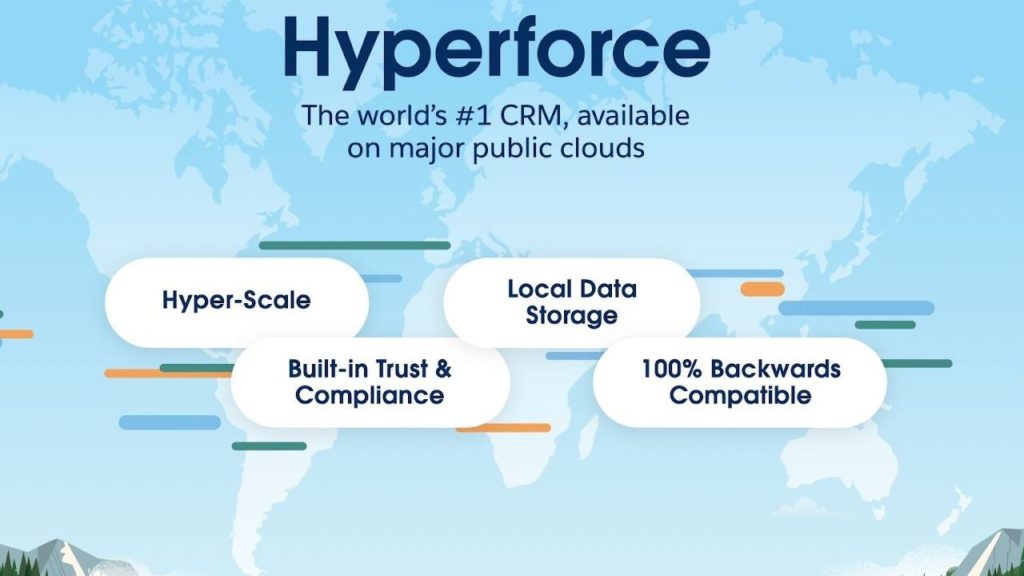Salesforce Hyperforce represents a significant evolution in the company’s infrastructure, transitioning to a cloud-native architecture that leverages the public cloud to deliver enhanced scalability, security, and compliance for Salesforce applications. This transformation enables organizations to deploy Salesforce services globally, ensuring data residency requirements are met while benefiting from the agility and innovation inherent in cloud computing.
Key Features of Salesforce Hyperforce
- Data Residency Control
- Regional Data Storage: Organizations can specify the geographic location for data storage, facilitating compliance with local data regulations.
- Localized Performance: By co-locating Salesforce applications with other regional systems, businesses can enhance application performance.

- Enhanced Security
- Secure-by-Default Architecture: Hyperforce employs least-privileged access controls and zero-trust principles to ensure robust security.
- Data Encryption: Customer data is encrypted both in transit and at rest, safeguarding against unauthorized access.
- Scalability and Agility
- Elastic Computing Resources: The architecture provides flexible computing resources, allowing businesses to scale operations efficiently to meet dynamic demands.
- Rapid Deployment: Hyperforce supports the swift deployment of Salesforce applications across various regions, facilitating global expansion.
- Compliance and Privacy
- Regulatory Adherence: Hyperforce integrates enhanced standards for compliance, enabling organizations to adhere seamlessly to local and international regulations.
- Privacy Controls: Salesforce maintains a commitment to privacy, offering transparent controls to safeguard customer data.
Benefits of Upgrading to Hyperforce
- Global Deployment: Organizations can deploy Salesforce applications in multiple regions worldwide, ensuring proximity to users and compliance with local laws.
- Operational Efficiency: The cloud-native architecture reduces the need for extensive hardware management, lowering operational costs and complexity.
- Accelerated Innovation: Hyperforce’s flexible infrastructure allows for quicker adoption of new Salesforce features and services, driving business innovation.
Getting Started with Hyperforce
The following table outlines the essential steps and considerations for a successful upgrade:
| Step | Description |
|---|---|
| 1. Assess Readiness | – Evaluate Current Environment: Review your existing Salesforce setup to determine compatibility with Hyperforce. – Identify Dependencies: Locate any hard-coded references, such as specific instance URLs (e.g., na12.salesforce.com), and plan to update them to dynamic references.– Review Integrations: Ensure all integrations support HTTP/1.1, as Hyperforce does not support HTTP/1.0 requests. |
| 2. Plan Migration | – Develop a Strategy: Create a comprehensive migration plan covering data transfer, application deployment, and user training. – Schedule Downtime: Coordinate with stakeholders to schedule the migration during a maintenance window, typically resulting in approximately three hours of read-only access. – Communicate Changes: Inform all users about the migration timeline and any expected impacts. |
| 3. Execute Migration | – Utilize Hyperforce Assistant: Leverage the Hyperforce Assistant tool available in the Setup menu to perform automated readiness checks and follow guided steps. – Monitor Process: Closely observe the migration to address any issues promptly, ensuring data integrity and minimal disruption. |
| 4. Post-Migration Optimization | – Validate Functionality: Test all applications and integrations to confirm they operate correctly in the new environment. – Update Configurations: Recreate or refresh sandbox instances, as they are not automatically migrated. – Enable Enhanced Domains: Ensure that enhanced domains are activated to support the new infrastructure. – Review Security Settings: Update IP allowlists and firewall rules to accommodate new Hyperforce IP ranges. – Provide Training: Offer user training sessions to familiarize staff with any new features or changes. |